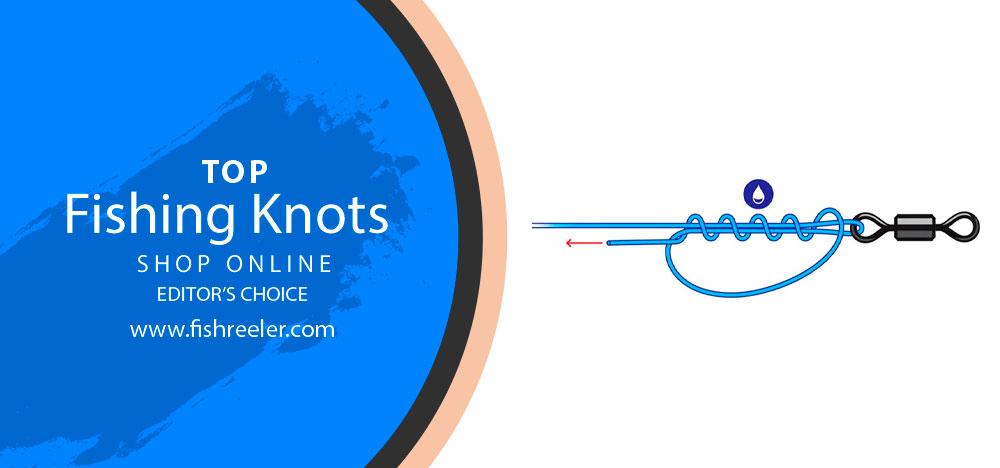
Unraveling the Art of Fishing Knots: A Professional Angler’s Journey
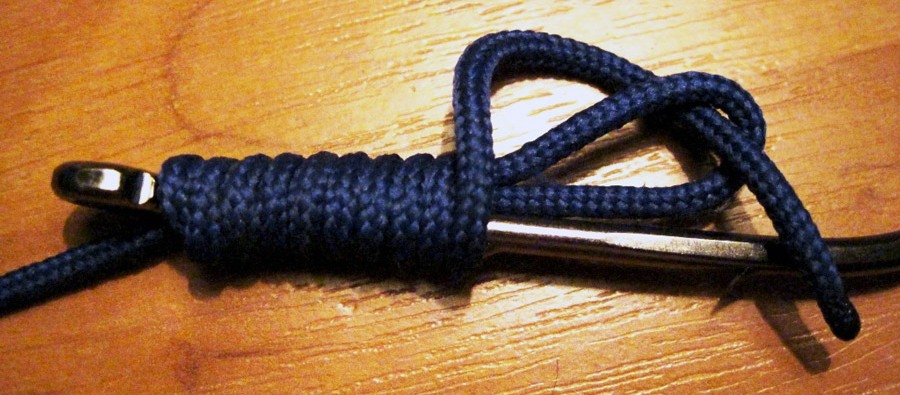
On a balmy summer morning many years ago, I found myself standing on the dew-kissed bank of a local river. In my hand, a fishing rod that felt like an alien object, a birthday gift from my grandfather. As the morning mist played hide-and-seek with the sun’s first rays, I cast my line into the tranquil water, my heart pounding with anticipation. But my novice excitement was quickly replaced by disappointment as I watched my bait and hook, detached from the line, sinking into the depths. The culprit? A poorly tied knot.
🎣 The First Cast: How a Simple Knot Sparked a Lifelong Journey
That was the day I understood a fundamental fishing truth: the success of an angler is not measured by the sophistication of their gear or the prowess with which they can cast a line. No, the true game-changer, the unsung hero of every successful fishing expedition, is the humble knot. 🪢
The art of knot-tying is an indispensable skill in the angler’s arsenal, as crucial as the rod and the bait. It acts as the linchpin that connects you to your catch, the silent accomplice ensuring that your hours by the water yield more than just inner peace.
Fishing knots are not just practical; they’re a metaphor for the discipline and patience required in angling. They remind us that the thrill of the catch is often preceded by meticulous preparation and diligent learning. The fisherman’s knot is more than a functional necessity; it’s a rite of passage, a testament to our connection with nature, and a nod to the generations of anglers who have passed on their wisdom through these intricate ties.
🔶So, whether you’re a seasoned angler or a budding fisherman, let’s dive deeper and unravel the beautiful complexity of fishing knots. After all, every catch has a story, and every story begins with a well-tied knot. 🐟
🌊 Hooked for Life: My Personal Odyssey into the World of Fishing
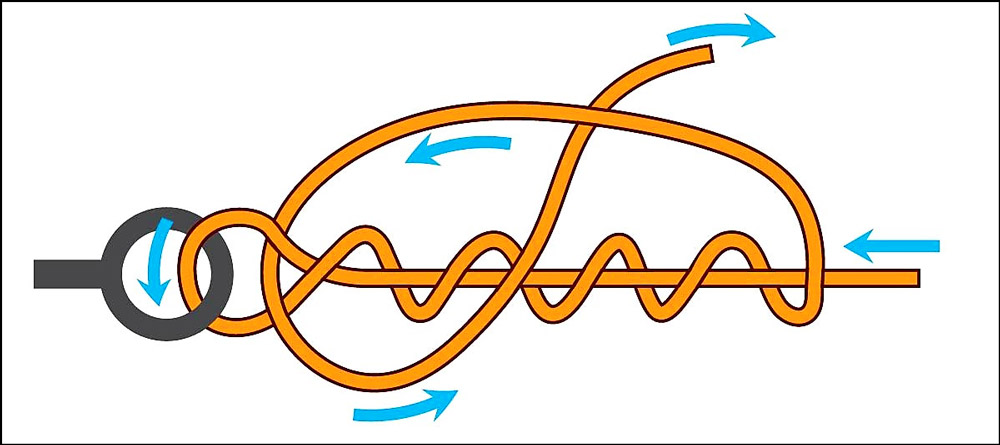
My affair with fishing began as a quiet curiosity and swiftly blossomed into a passion that has shaped my life. Fishing is not just a hobby to me. It’s a sanctuary, a teacher, and a bridge that connects me to the unspoiled beauty of nature. 🏞️
Ever since my first botched fishing expedition, I’ve spent countless hours by rivers, lakes, and seafronts, each catch teaching me a little more about the aquatic world and, surprisingly, myself. Over the years, the sounds of flowing water, the gentle tug on the line, and the thrill of a successful catch have become my most cherished symphony. 🎣
However, the journey wasn’t always smooth sailing. I still remember the frustration of losing countless catches due to poor knots. I knew how to cast, where to cast, what bait to use, but the art of knot-tying eluded me. And in fishing, a weak knot can undo all your skills and effort.
With time, I began to appreciate the knots for what they were – a crucial link in the chain that was my fishing journey. From learning the basic Clinch Knot to mastering the complicated Bimini Twist, I realized that each knot was a stepping stone to becoming a better angler. 🪢
But learning to tie the perfect knot was not merely a practical victory; it was a transformative experience. It brought a new level of depth to my fishing expeditions, fostering a sense of completeness in my skill set. I could approach each fishing adventure with renewed confidence, knowing that my knots wouldn’t let me down.
🔶Embracing the world of fishing knots didn’t just enhance my fishing prowess; it deepened my love for the sport. So, let’s navigate the enchanting labyrinth of fishing knots together, because trust me, the journey is as rewarding as the destination! 🗺️🐟
🔍 Beyond the Bait: Unveiling the Critical Role of Fishing Knots
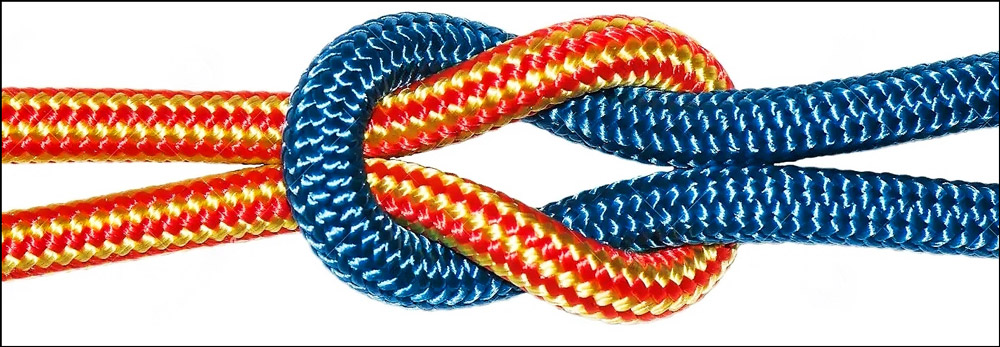
Fishing knots, often overlooked in the grand scheme of angling, are, in fact, the silent backbone of any successful fishing expedition. But what exactly is a fishing knot? And why is it so crucial? 🤔
A fishing knot is a specific type of knot designed to secure your fishing line to your hook, lure, or swivel. It is your faithful link between the rod and the water, the unsung hero that ensures your trophy fish doesn’t just become ‘the one that got away.’
Choosing and tying the right knot is like a silent conversation with the elements: the fish, the water, and the line. It’s an art and a science, combining ancient maritime wisdom with modern angling knowledge. 🎣
Several factors influence the strength and effectiveness of your fishing knot:
- Line Material: Different materials like monofilament, fluorocarbon, or braided lines require different knots due to their unique properties.
- Fish Species: Different fish species and their behaviors can impact the choice of knot. A larger, more aggressive fish might require a stronger, more complex knot.
- Type of Bait or Lure: The type of bait or lure you’re using may necessitate a particular knot to ensure it’s presented in the most appealing way to your target fish.
- Fishing Conditions: The fishing environment, including factors such as water depth, temperature, and current, can affect the choice and durability of your knot.
🔶In essence, fishing knots are not a one-size-fits-all solution. A successful angler knows that the right knot is often as critical as the right rod, reel, or bait. This understanding will not just improve your catch rate but deepen your relationship with the art of angling itself. So, let’s embark on this voyage to knot perfection together! 🚀 🐟
How to Tie a Reliable Knot For a Fishing Line?

There are no trifles when you do fishing – this is an axiom that experienced fishermen constantly repeat. Very often, not only the quantity of the prey but also its quality depends on the reliability of the selected tackle: trophy fish are not to be caught by unprepared equipment. Knots on the fishing line – one of such important trifles. The knot itself is small, even almost invisible. But this is an extremely important part of fishing equipment because without knots it does not exist.
Before Starting:
- Choose the right fishing knot and tie it.
- Add moisture to the knots with water or saliva before tightening it down.
- Check if your knots perfectly tighten.
- Cut tag ends of your knot.
- Try, use, practice!
During the fishing, the fishing line inevitably carries a certain load. Knots on it, too.
The main factors of successful fishing depend on the reliability of the knot:
- The catch of large or highly resistant fish is impossible without strong joints;
- A reliable knot will allow you to save tackle with hooks and any other load;
- An improperly tied, too voluminous knot can ruin and nullify all fishing: it will be too noticeable in the water and therefore scaring away the fish, and passing through the rings, it may interfere with the range and accuracy of these castings.
🔶So, what the best fishing knot for braided Line to swivel, hook, or lure connection is? Let’s match the most popular knots against one another to determine which one truly is the best fishing knot for a braided line to a swivel, hook, or lure.
🪢 Mastering the Ties That Bind: Key Knots Every Fisher Must Know
Knowing your knots is knowing your craft. Each knot has a purpose, a strength, and a unique role to play. Here, we unveil essential fishing knots that every angler should have in their repertoire. 🎣
Improved Clinch Knot
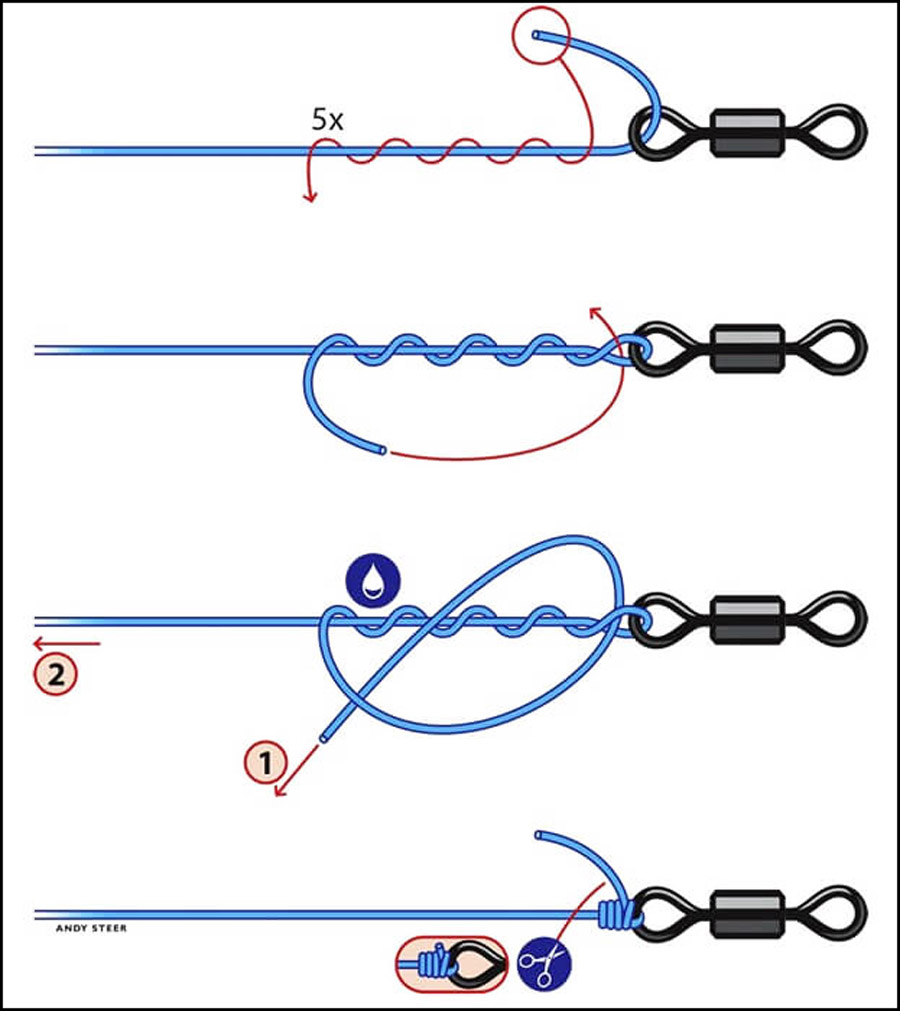
The Clinch Knot is an easy and versatile knot, ideal for attaching a hook, lure, or swivel to your line. It works well with most lines and is perfect for light-tackle fishing.
Improved Clinch is a knot that many anglers can tie with their eyes closed or in total darkness. Suitable for different woods and flood materials. A simple Clinch differs little from an improved one, in it, at the last step, the tip of the fishing line is not held in a large loop. They are considered the best fishing units for hooks, leashes, nozzles, carbines, and swivels. It has high strength, but only when using braids or monofilaments with a diameter of up to 0.4 mm. If you take more, the reliability of the node is reduced. It is easy to tie since it does not have complex weaves.
The Improved Clinch Knot is one of the most widely used fishing knots. It provides a good method of securing a fishing line to a hook, lure, or swivel. The “improved” version shown here includes an extra tuck under the final turn.
The Improved Clinch Knot is seen as a fisherman’s reliable knot. It is suited for attaching a small diameter tippet to a heavy wire hook. This particular knot is strong, firm and reliable for every fisherman for it can withstand a battle with big fish.
Given its performance and relative difficulty to tie, I recommend not using this one so did include a how-to video. Click here:
How to Tie:
- Thread the line through the eye of the hook, then double back on itself.
- Twist the line five to seven times.
- Pass the end of the line through the loop near the hook eye.
- Thread the line through the big loop you’ve just created.
- Wet the knot with saliva or water, then pull it tight.
Palomar Knot
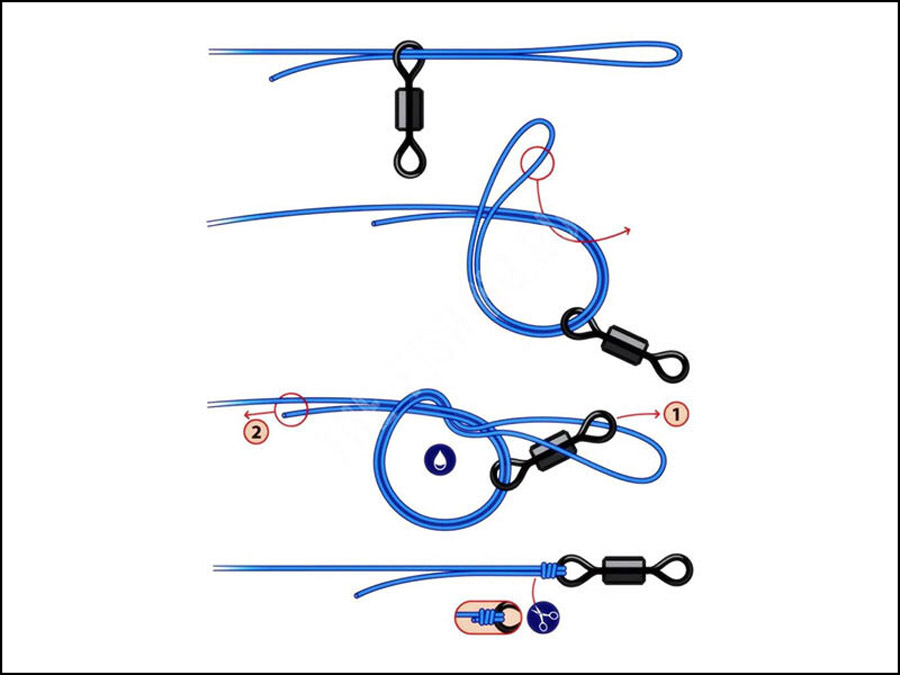
The Palomar Knot is one of the simplest and strongest knots. It’s particularly effective with braided lines and is great for tying on hooks and lures.
The Palomar knot is a simple but very reliable knot for tying hooks, swivels, and other accessories. This is the main knot for some braided cords. The Palomar node is used everywhere when you need to bind something small. Suitable for woods of any type – for monofilament and braided cord, nylon, and fluorocarbon.
Many fishermen believe that the Palomar Knot is the best fishing knot. Palomar Knot is an excellent knot when tied properly. Be sure that when the hook or lure is passed through the loop that all parts of the knot girth up together. The knot can fail if tied in an incorrect manner. This is also the best knot to use with braided lines. If you want to see the video of this process click here:
How to Tie:
- Double about 6 inches of line and pass it through the eye of the hook.
- Tie a simple overhand knot with the double line.
- Pass the loop over the hook.
- Wet the knot and pull it tight.
Blood Knot
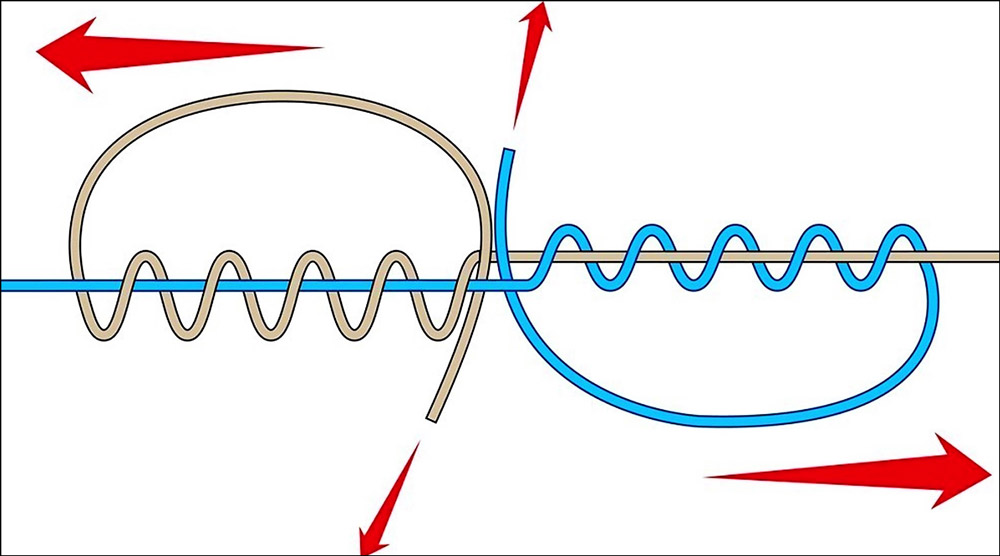
The Blood Knot is excellent for tying two pieces of similar fishing line together, especially if you need a strong and smooth connection.
How to Tie:
- Overlap the ends of lines you want to join.
- Twist one line around the other five times, and then do the same with the other line.
- Insert the end of one line into the loop that was formed at the opposite end.
- Wet the knot and pull on both lines.
Uni Knot
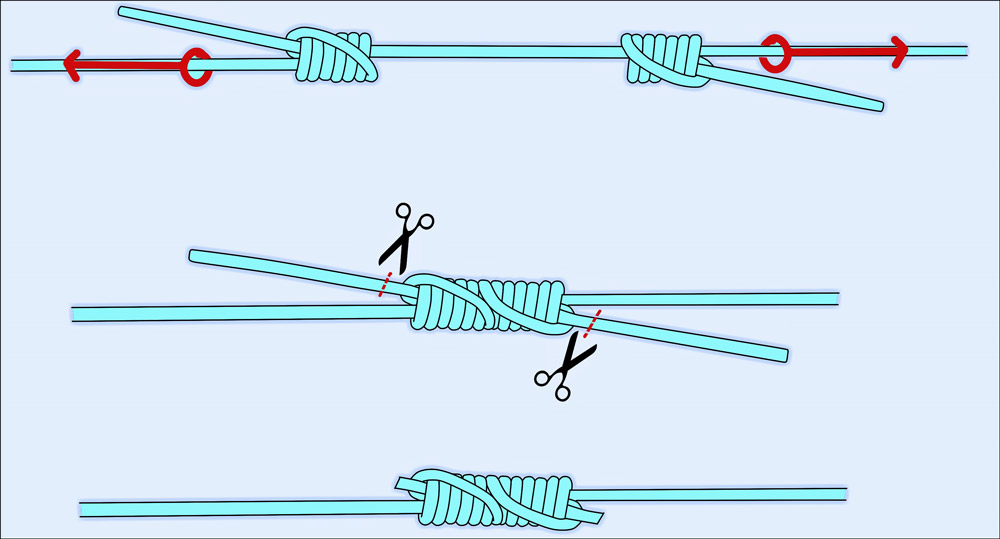
The Uni Knot is a highly versatile knot that can be used for attaching the line to the hook or for joining two lines. It’s also easily adjustable.
The Uni knot is a multipurpose fishing knot that can be used for attaching the fishing line to the arbor of a reel, for joining lines, and for attaching lures, snaps, and swivels.
The Uni Knot was invented by Norman Duncan and is also known as the Duncan Knot. It was also published later under the name Uni Knot by the outdoor writer Vic Dunaway as being a versatile knot that can have many applications. When used to join two lines it is known as a Double Uni Knot.
This knot is used by anglers in both salt and freshwater to join lines of similar or different strengths. It works very well and some think that it was easier to tie than the Blood Knot. When tying in braided line to monofilament, make 8 turns with the slippery braided line and 5+ turns with the mono. Click here to see the instructions on how to tie both kinds of knots:
How to Tie:
Pass the line through the eye of the hook.
Double back and make six turns around the line.
Pass the end through the first loop above the eye, then through the big loop.
Wet the knot and pull it tight.
Double Uni Knot
Trilene Knot
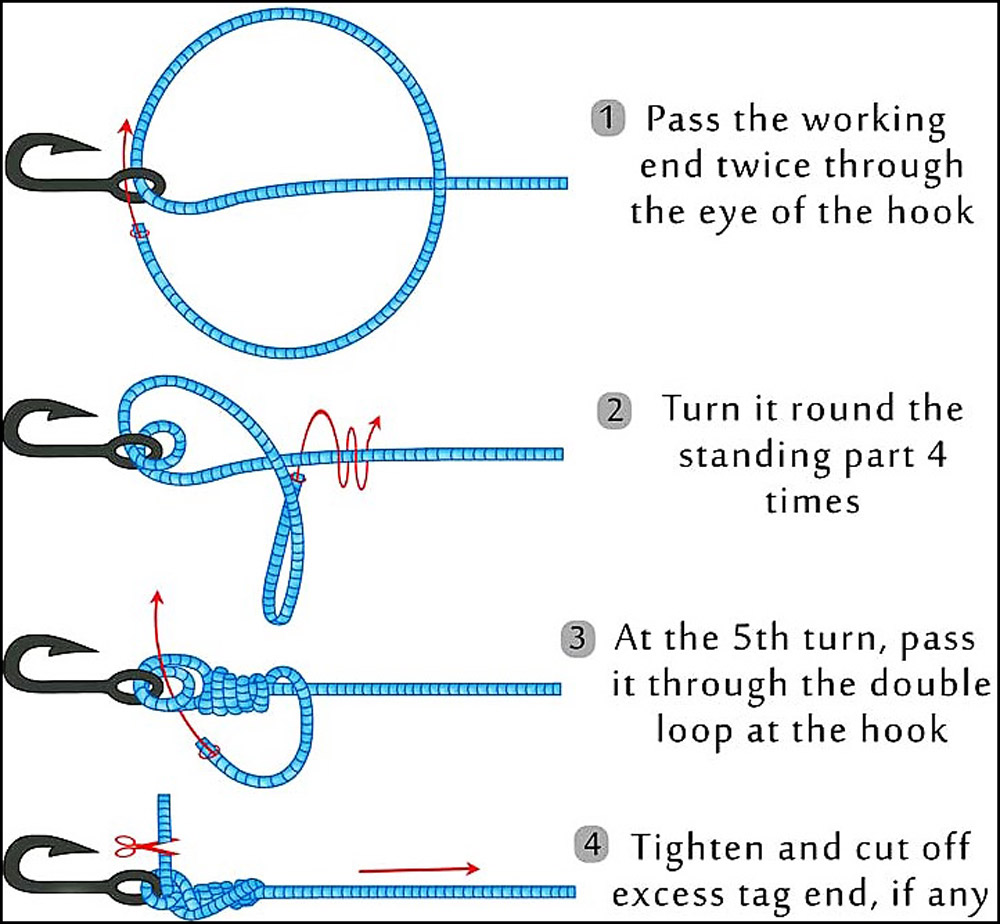
The Trilene knot is a powerful and reliable fishing knot that is effective in tying a monofilament or fluorocarbon line to swivels, hooks, snaps, and lures. It is known to retain about 85-90% of the line’s original strength. It was researched and developed by the Berkley tackle company and is recommended by them to tie the monofilament. I find it works especially well on the fluorocarbon line and leaders, preventing the knot from coming loose in the fight. Click here:
San Diego Jam Knot
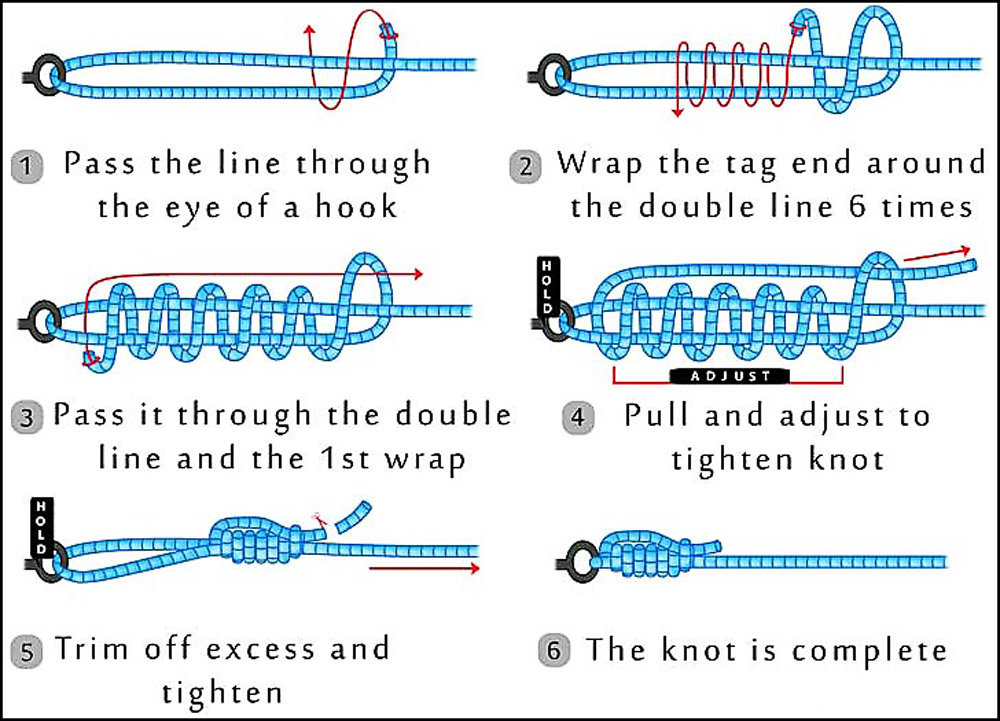
This knot was very “famous” only in the fishing capital of San Diego but later gained widespread recognition with anglers all over the world as an excellent knot. It attaches a line to a swivel, hook, artificial fly, or clip. Also known as the reverse clinch or the Heiliger knot it can be tied with many types of fishing lines including fluorocarbon, monofilament, and braided v/s the Palomar knot is not as powerful with braid as it is with mono. It has won “stormy” reviews with fishermen. Click here:
Grinner Knot
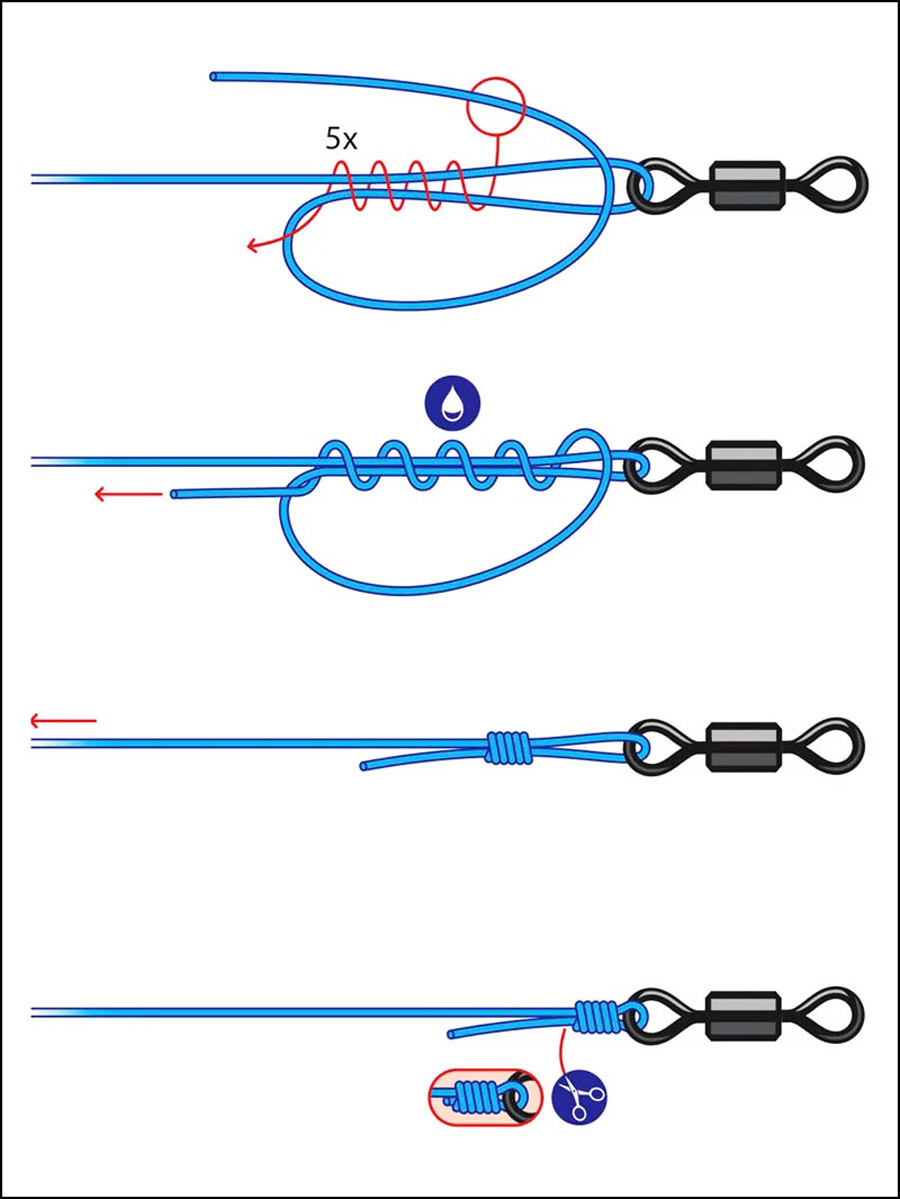
The Grinner or Uni Knot node is essentially the same node with different names. It is used for fastening hooks, swivels in various snap-ins. No less than the previous Palomar knot is popular, and also, it is one of the main ones for some wicker woods. In addition to its direct purpose, in feeder fishing, Grinner is used for looping floating Pop-Up nozzles in some types of carp and feeder assemblies.
Knotless Knot
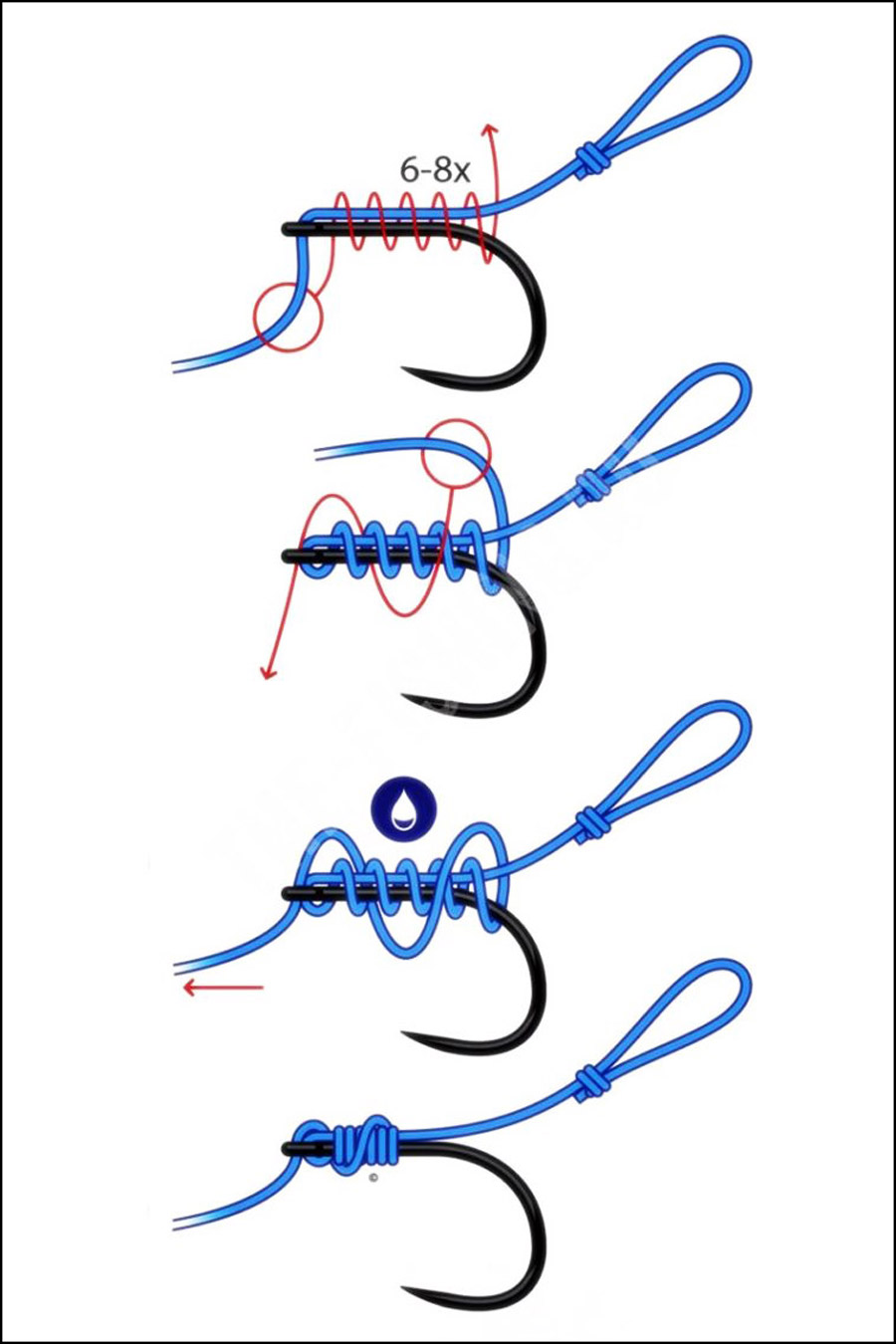
A knotless knot, allows you to quickly snap a hair snap hook. This is the knot that every “carp” knows. The length and freedom of hair can be determined by the number of turns of fishing line around the forend of the hook. Node Fishing Knot is used to create a hair snap. It is mainly used for braids. Simple in execution, but very sturdy and reliable. To make it even more reliable, it is recommended to lay the turns of the fishing line evenly, without fly fishing. You can additionally use glue.
Marker Fishing Unit
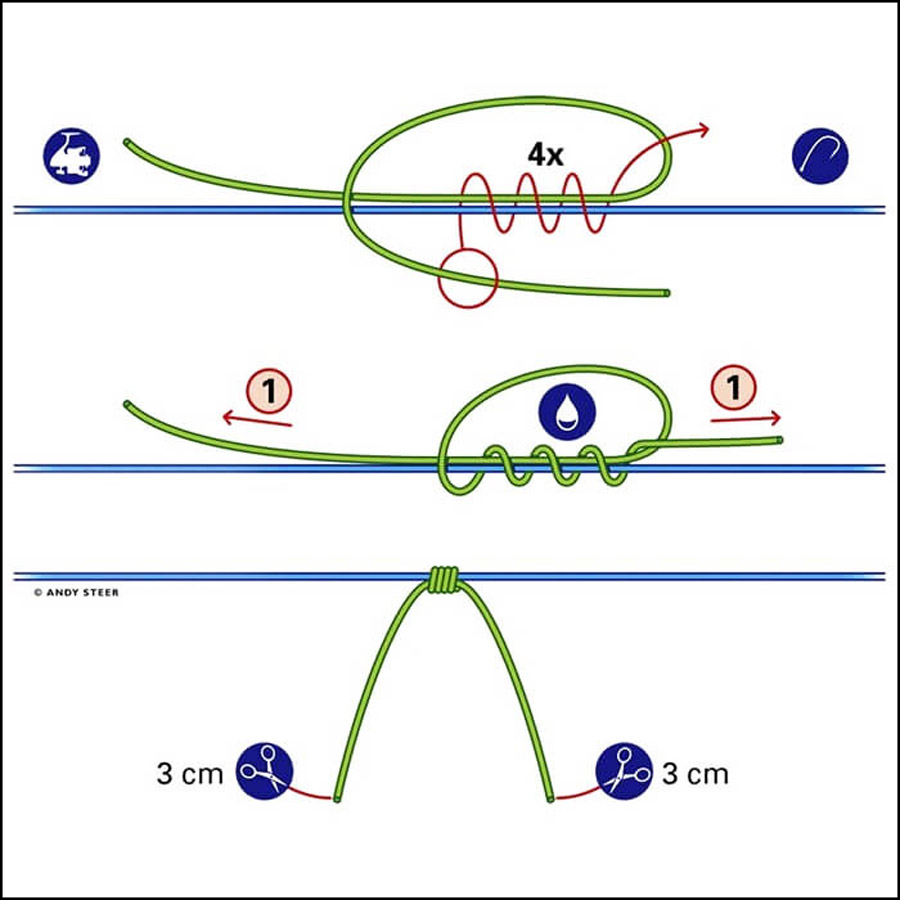
It is used for feeder gear. Usually, a special elastic material is used, which is attached to the main fishing line and serves to indicate the measuring marks. This is the most durable fishing unit, does not slip on the fishing line. If necessary, it can be quickly removed: pull the ends of the elastic thread and pull it out of the knot. After removal, a slight deformation will remain, but it will not have a negative impact on the working qualities of the fishing line.
Leader Knot
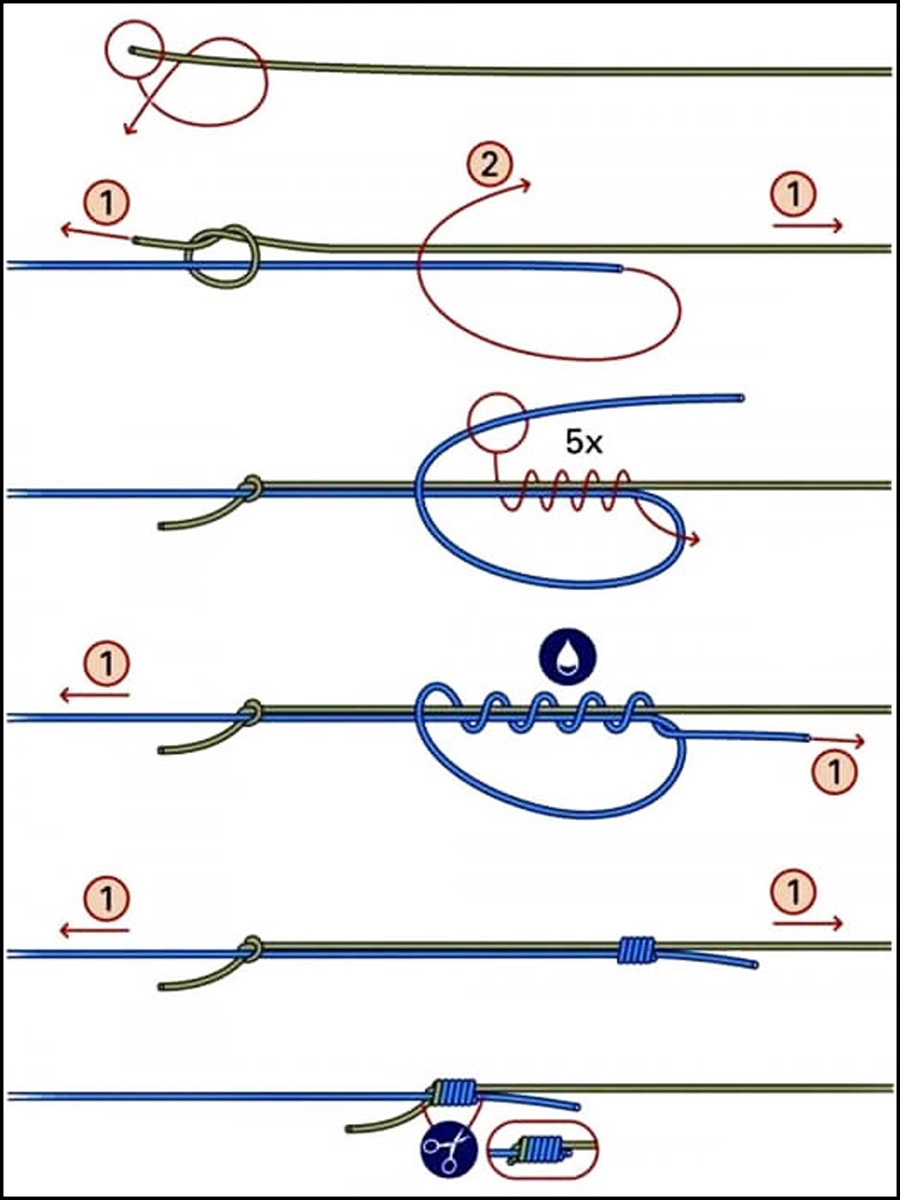
Leader Knot is a simple knot that serves to connect the shock leader with the Main Line of the feeder gear. The shape of the knot allows the fishing line to pass through the rod rings almost unhindered. Used for feeder gear: tie the shock leader to the main fishing line. Securely fastens the 2 ends of the fishing line, even with different diameters and types. At the junction, the knot is very neat, but the strength is 80%. Any novice fisherman can learn to knit such a knot.
Mahin Knot
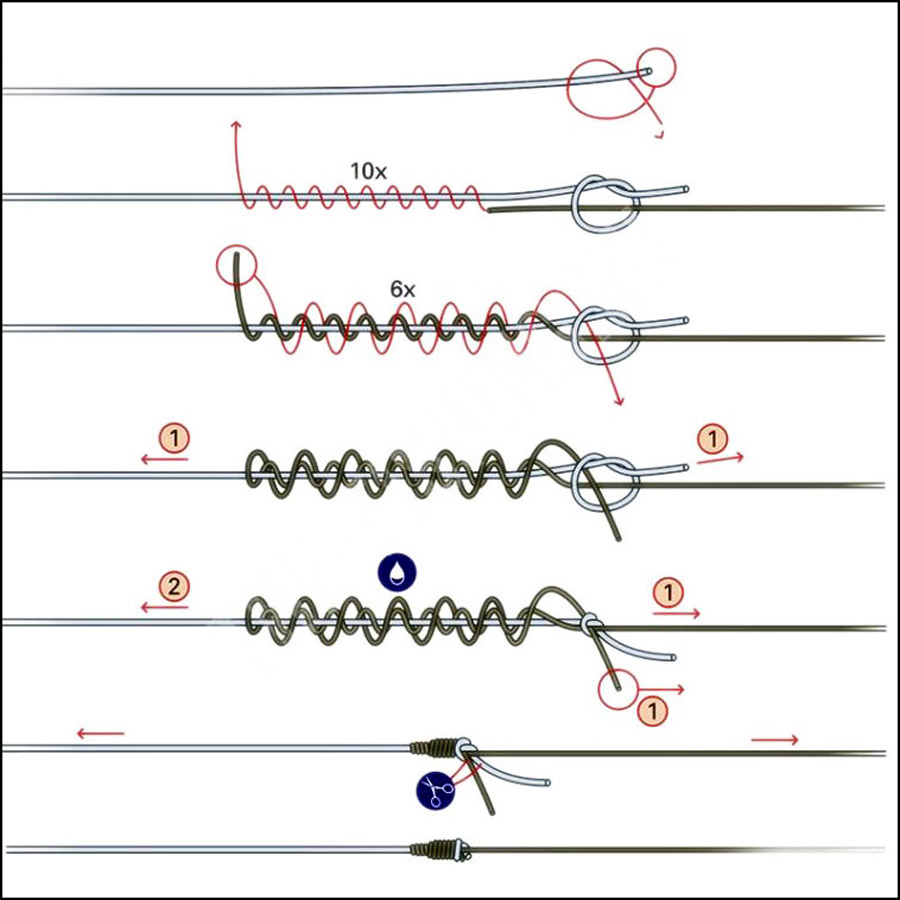
Mahin Knot is one of the few knots suitable for binding fluorocarbon to another fishing line, whether it be a braided cord or monofilament. The pointed form of the knot, for which it was called Carrot, allows you to use it to connect the main fishing line with the shock leader. Suitable for linking any woods in different combinations among themselves.
Simple Loop Fishing Knot
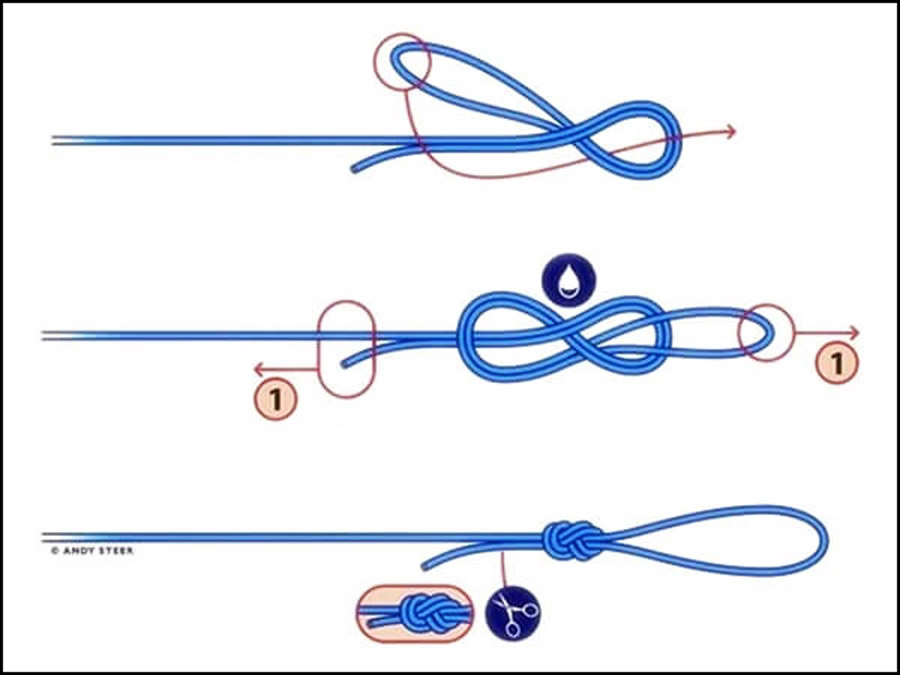
Universal node. Bits of help fasten leashes and floats. In water, it is invisible. Its strength is very high, but it is performed quite simply. Suitable for monofilament and braids. Such a node is used on an industrial scale. And also there are all kinds of variations.
Albright Fishing Unit
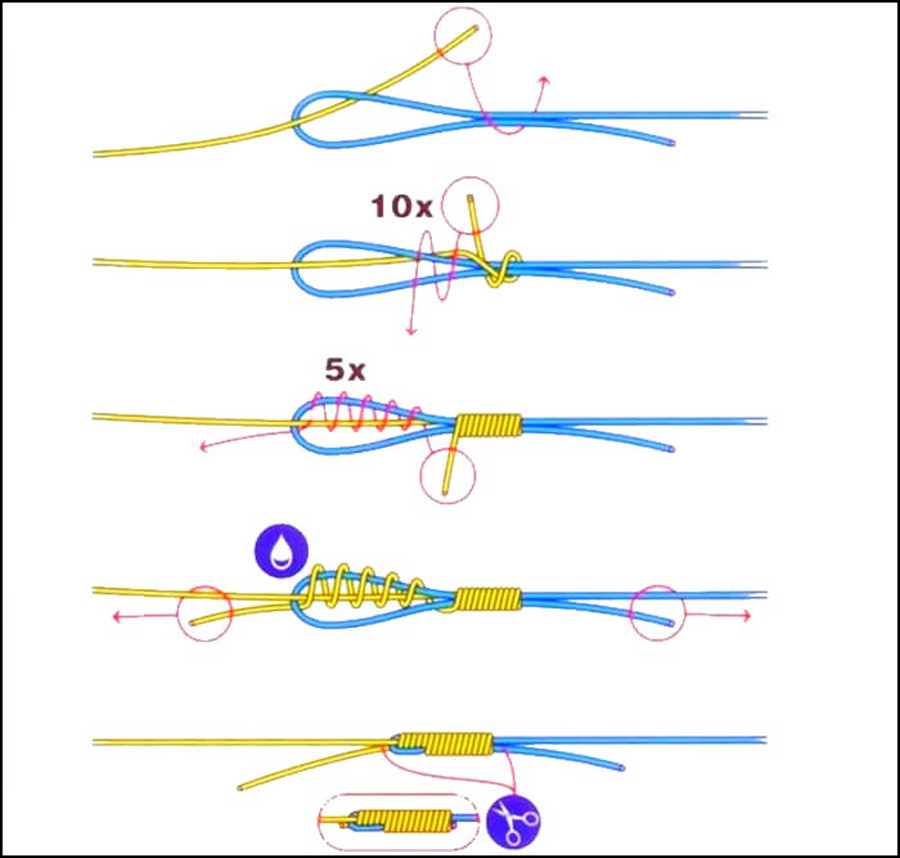
It has high strength. It is used to fasten the leash and the shock leader to the baseline and when fishing in difficult conditions, when there is a risk of tearing the equipment. Tightly connects 2 fishing lines with each other, even of different diameters and structures. It’s easy to master.
Snell Fishing Unit
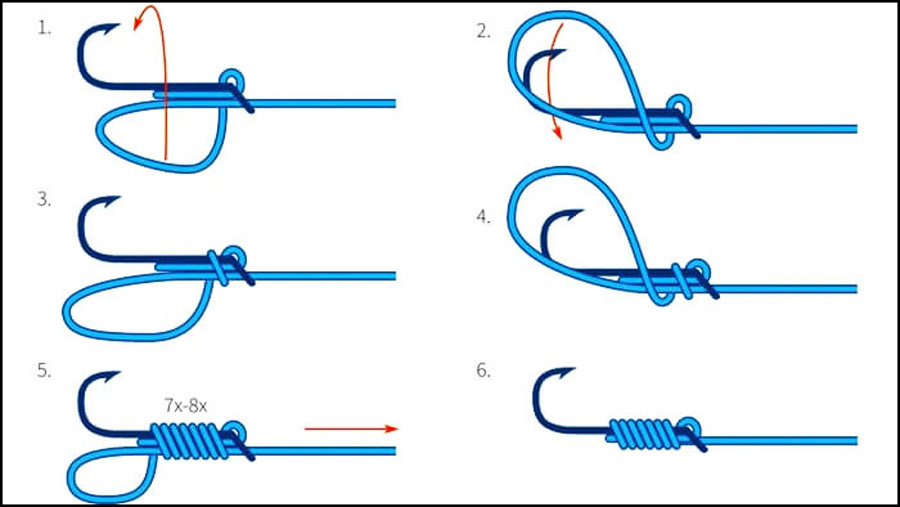
This is the simplest hook fishing unit that applies to different fishing lines: monofilaments and braids of various diameters. It is attached to the forearm and has excellent durability. When pulling a caught fish, it distributes the load throughout the entire rig. Therefore, aggressive jerking fish will not spoil the fishing line.
How To Tie Two Fishing Lines
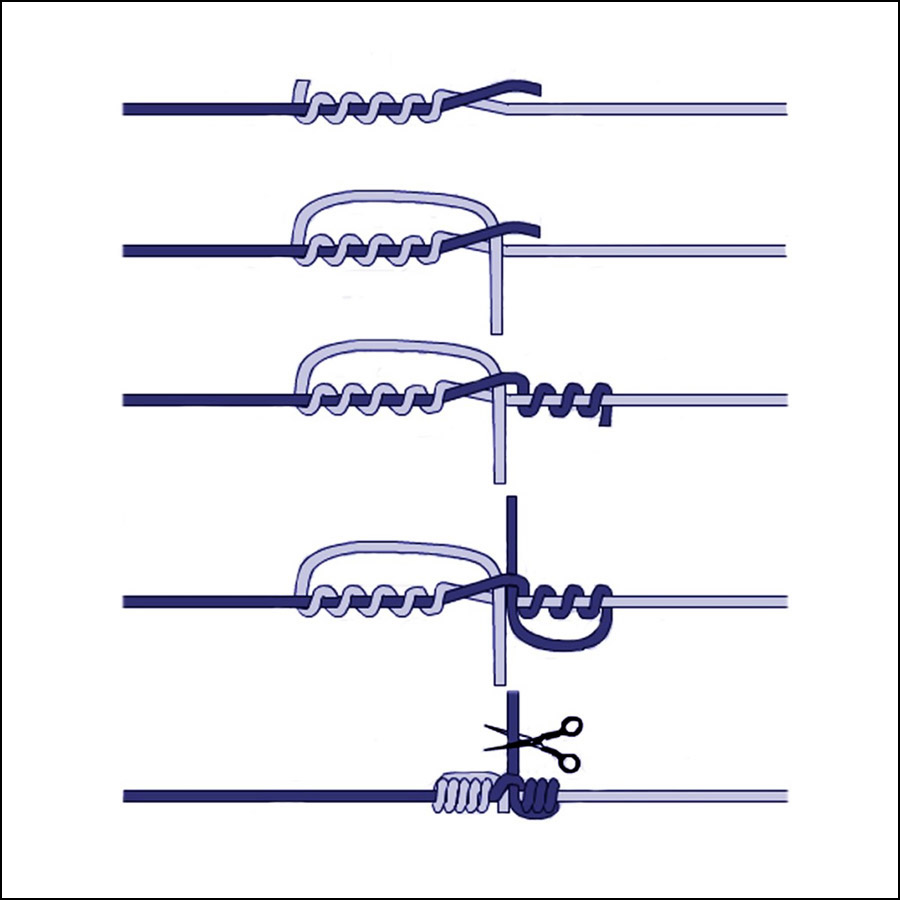
Quick Loop
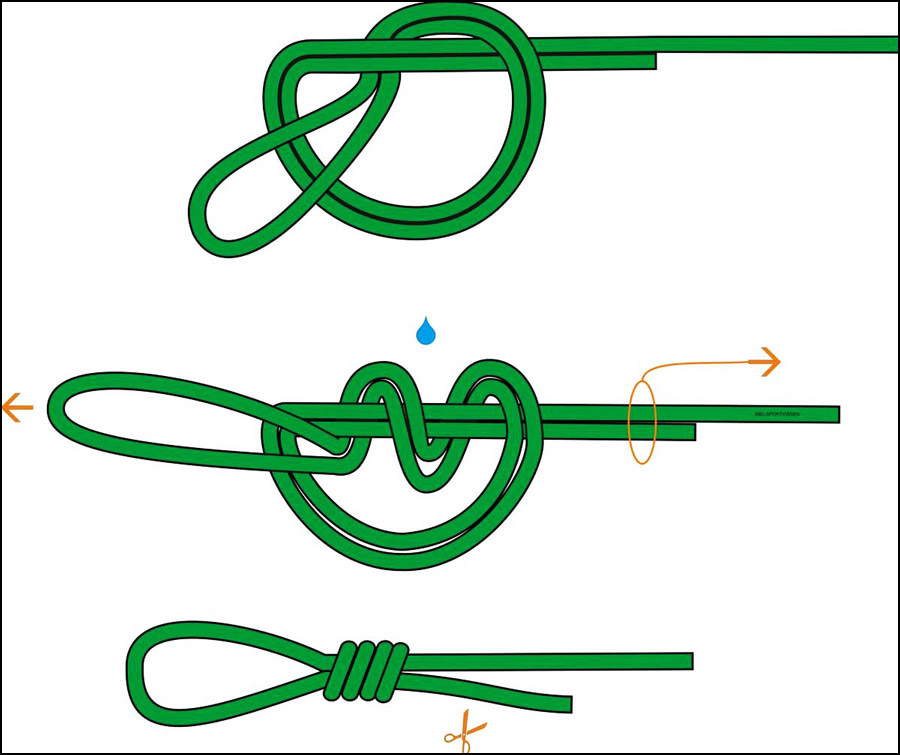
Comfortable Loop

Dead Fishing Loop

Reinforced Fishing Loop
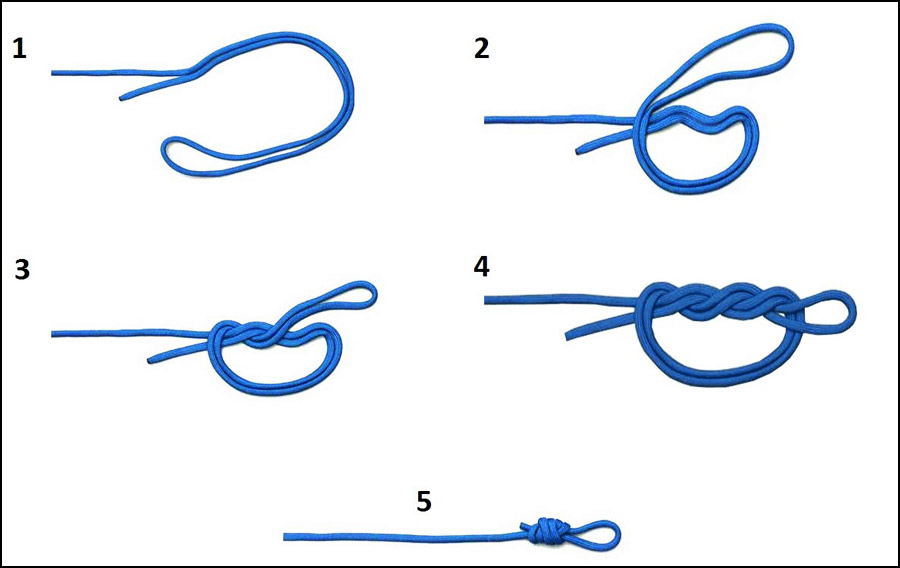
Fixed Loop Assembly

The Loop On The Main Line
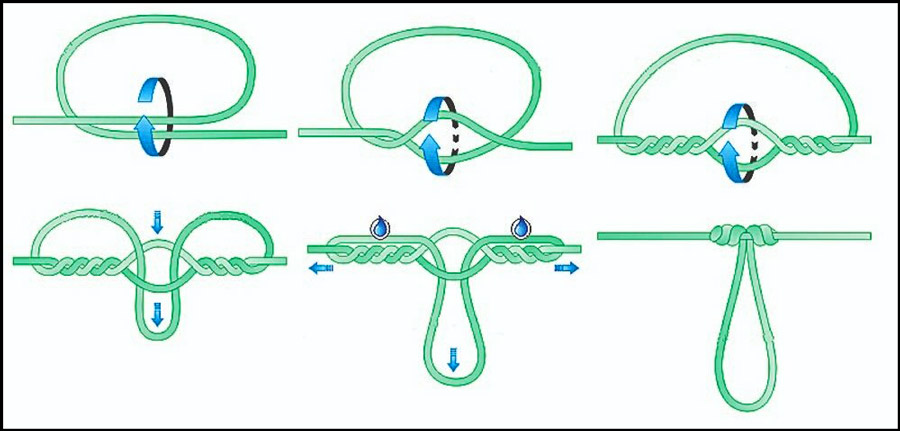
Useful Knots for Fishing

Rapala Knot for Lures
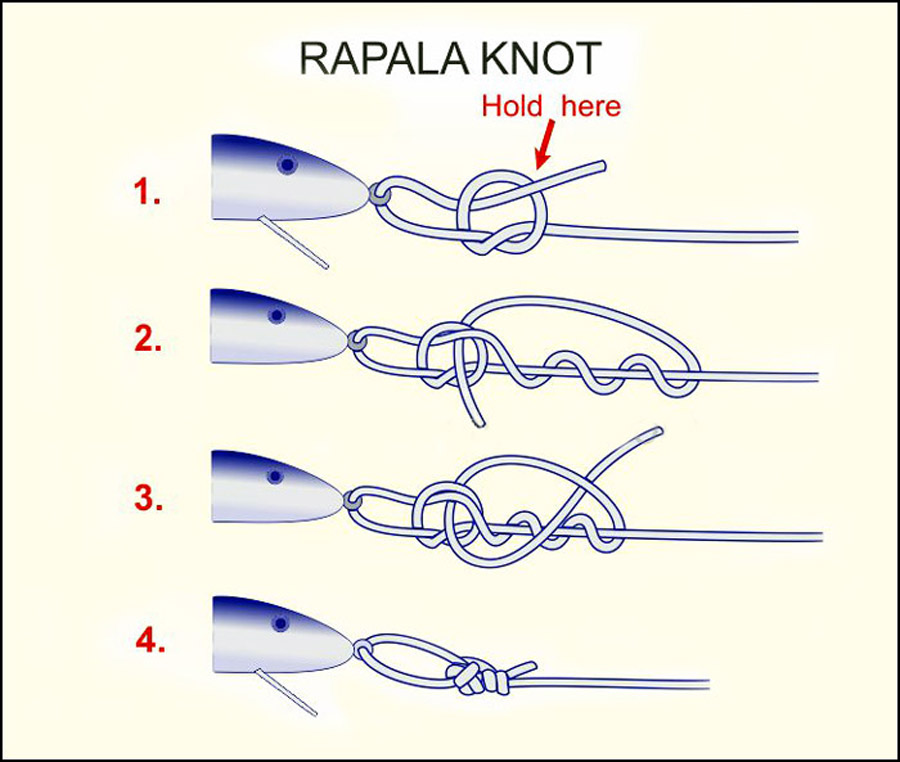
🔶Remember, practice makes perfect. Repeatedly tying and testing these knots will enhance your proficiency and speed. A well-tied knot is the first step to an unforgettable fishing story. 🐟
📖 Tales from the Deep: When Knots Become Game-Changers
Every knot has a story, and every story adds a new dimension to the vast tapestry of angling adventures. Here, I’d like to share a couple of experiences where my choice of knot played a pivotal role in my fishing story.
The Palomar Knot Triumph 🏆
Picture this: A quiet summer evening on Lake Tahoe, my favorite fishing spot. I had been fishing for a while, using a Clinch Knot with no luck. On a whim, I decided to switch things up and tie on a Palomar Knot. With this simple knot change, my lure presented differently in the water.
In no time, I felt a strong pull on my line. After a thrilling tug-of-war, I reeled in a splendid rainbow trout, my largest catch of the season. That was the day I truly understood the power of a well-chosen, well-tied knot. It was the Palomar Knot’s simplicity and strength that clinched the victory for me!
The Uni Knot Rescue 🎣
Once, during a deep-sea expedition, I found myself face-to-face with a feisty marlin. Excitement turned to despair when my line snapped, leaving me to rue a lost opportunity. The Blood Knot I’d used to join two lines had given way under the marlin’s strength.
Not to be disheartened, I retied my lines, this time with a Uni Knot, known for its exceptional strength and reliability, especially in heavy-line conditions. The difference was immediate. With the Uni Knot firmly in place, I was able to withstand the marlin’s powerful runs and leaps and finally land the impressive fish.
🔶These experiences have taught me that while not every day on the water will be triumphant, each one offers valuable lessons. And often, these lessons center around the vital art of knot-tying. So remember, the right knot can mean the difference between a tale of the one that got away and a triumphant fishing story to tell. 🐟
🧠 Master the Art of Knot-Tying: Pro Tips and Tricks
Whether you’re a novice angler or a seasoned fishing enthusiast, mastering the art of knot-tying can take your fishing experience to a whole new level. Here are some valuable tips to help you perfect this skill:
- Practice Consistently: Just like learning to play a musical instrument or mastering a new language, practice is key when it comes to knot tying. Keep a fishing line handy at home, and practice your knots during your downtime. 🏡
- Keep it Wet: When tightening your knots, always moisten them with saliva or water. The heat generated by friction when pulling a dry knot tight can weaken your line, leading to a lower breaking strength. 💦
- Test Your Knots: After tying your knot, it’s essential to test it by tugging on the line. This ensures the knot is properly tied and ready to handle the weight of a catch. 🎣
- Don’t Rush: Take your time to tie your knots correctly, especially when learning a new one. A rushed knot can result in a poor fishing experience, even with the best of gear. 🐢
- Use Tools: There are numerous tools available, like knot-tying tools and line clippers, that can assist you in creating strong, secure knots. These can be particularly handy when fishing in cold weather when your fingers may not be as nimble. 🔧
- Learn From Mistakes: Every missed fish is a lesson. If a knot fails, don’t just tie another one and hope for the best. Take the time to figure out what went wrong. It’s these lessons that turn good anglers into great ones. 🎓
🔶With these tips in your angling arsenal, you’re well on your way to becoming a master in knot-tying, ensuring that your fishing tales are ones of victory and joy! 🐟🏆
Tools and Devices that Help the Angler to Tie Knots
| Tool | Description | How It Helps |
|---|---|---|
| Knot-Tying Tool | A specialized device designed specifically for tying a variety of fishing knots. They come in several designs and sizes catering to different types of knots and fishing lines. | Knot-tying tools make the process easier, especially for beginners, by providing a solid base to work on and often guide the line into the correct positions. They can also protect your fingers from potential injury. |
| Line Clippers | A cutting tool designed to precisely cut fishing lines. | Using line clippers ensures a clean, even cut, which is essential for the knot’s strength. It’s also safer and more efficient than using a standard pair of scissors. |
| Hook Sharpeners | A tool used to maintain the sharpness of your hook. | Although not directly related to knot-tying, hook sharpeners are essential to ensure the effectiveness of your setup. A sharp hook is more likely to catch a fish and hold it securely, ensuring that your well-tied knot does not go to waste. |
| Fishing Pliers | A multi-purpose tool that can cut line, remove hooks, and help tie knots. | Pliers can help pull knots tight, especially when dealing with tough, thick lines that are hard to pull by hand. They can also be used to hold small hooks steady while you’re tying a knot. |
| Needle Tools | A small tool with a pointed end, often included in knot-tying toolsets. | Needle tools can be helpful for intricate knot-tying processes where you need to thread the line through small loops or tight spaces. |
| Line Lubricant | A substance designed to reduce friction on fishing lines. | When tying a knot, lubricating the line reduces friction, which can otherwise weaken the line as you pull the knot tight. While water can also be used, a line lubricant is specifically designed to minimize friction without damaging the line. |
🤝 The Angler-Knot Symphony: An Unseen Connection
Fishing is more than just the act of catching fish; it’s a dance with nature, a dialogue between the angler, the water, and the fish. In this harmonious interaction, knot tying plays a crucial role, a role often as understated as it is essential. 🌊🎣
Mastering knots does more than just improve your catch rate—it deepens your connection to the very soul of angling. Each knot tied is a testament to your understanding of the environment, the species you’re after, and the very elements that govern your success. It is an exercise in patience, precision, and persistence—core attributes of a successful angler. 💪
Consider the act of knot-tying as a form of meditation—a moment of calm before the storm of action. As you thread the line and shape the knot, you’re not just preparing your gear; you’re attuning your senses to the rhythm of the water and the possibilities that lie beneath its surface. 🧘♂️
The joy of feeling a fish on the line is amplified when you know that your skills, including your knack for knot-tying, played a part in that success. And even when the fish don’t bite, the ability to adapt, to try a different knot or a different approach, is part of the timeless allure of fishing. 🐠🌟
So, next time you’re out on the water, take a moment to appreciate the subtle art of knot-tying and how it enriches your angling journey. It’s not just about the knots you tie, but the harmony you create between yourself, the fish, and the water. Remember, we’re not just fishing for the catch, but for the memories and the deep connection with nature that comes with it. 🌍🎣👏
🎣 Concluding Ties: Knot Just About Fishing
From our tales of triumphs and lessons learned to the meditative process of knot-tying, it’s clear that knots hold a pivotal role in the grand scheme of fishing. They’re more than mere connections between line and lure; they’re an embodiment of the art, the craft, and the passion that is angling. 🌊🐟
Perfecting the art of knot-tying isn’t an overnight task. It’s a journey filled with tiny victories, humble lessons, and rewarding experiences. From the versatile Clinch Knot to the mighty Uni Knot, each knot in your arsenal represents a tool, a skill, and an accomplishment in your angling adventure. 🔧💪
As we bring this knot-tying saga to a close, remember that every angler’s journey is unique, and so is their relationship with knots. So, keep exploring, learning, and tying, and let these knots be your steadfast companions in your journey through the vast waters. 🚣♂️
This knot testing is continuous because people are always seeking out the best method.
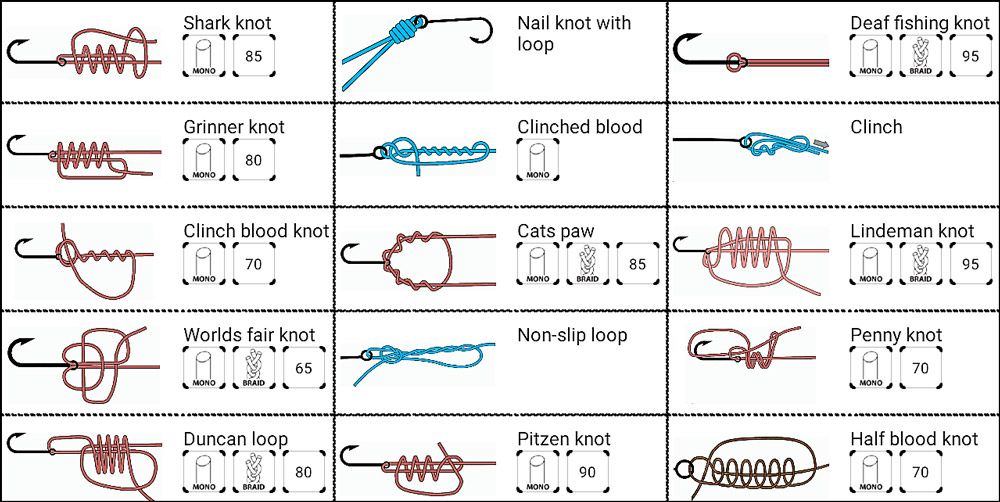
That’s all! By learning these easy fishing knots, you’ll probably be more flexible, much more prepared, and ready for your next fishing trip. Some practice and you will become an expert in no time!
I add a description and drawings of how to knit the main knots of the fisherman. In fishing, a large number of fishing units can be used. They can be divided into several categories according to their purpose.
Types of Fishing Units:
- Knots for hooks and lures
- Loop nodes
- Knots for attaching fishing line to the reel
- Fishing nodes for linking two lines
- Specific nodes
Knots can also be divided by the type of fishing line for which they are better suited.
Types of Fishing Lines Used:
- For braided fishing line
- For monofilament line
- For fluorocarbon fishing line
I invite you to share your own knot-tying experiences, triumphs, or even mishaps. Let’s learn together, grow together, and continue to celebrate the intricate art of fishing knot-tying. 📝👥
🔶Tight lines and perfect knots to you, fellow anglers. Here’s to the wonderful adventures that lie ahead! 🎣🏆
❓ Frequently Asked Questions: Fishing Knots 🎣💡
📢 Your Turn to Tie and Triumph!
Now that we’ve delved deep into the world of fishing knots, it’s time to put your knowledge to the test!
From the all-around useful Palomar Knot to the heavy-duty Uni Knot, there’s a whole sea of knots waiting to be mastered by you. Take your fishing line, follow the guides, and remember, practice makes perfect! 👌🎣
But don’t stop there; let’s create a ripple in the vast fishing community. Share your progress with us and your fellow anglers. Did you successfully tie a tricky knot? Did a particular knot aid in a spectacular catch? Or do you have some unique tips to share from your knot-tying adventures? Your story can inspire many others on their own fishing journey. 🗣️🌊
🔶So grab your line, tie a knot, and share your story. Together, let’s explore the endless possibilities that lie in a well-tied knot and the thrilling adventures that await in the world of fishing! 🌍🏆
Tags: #best fishing knot / #best knot for fishing hook / #best knot for fishing line / #best bass fishing knot / #what is the best knot for fishing / #how to tie the best fishing knot / #what is the best knot for braided fishing line

I live in Tenerife (Canary Islands) for the last 10+ years and share my daily fishing experiences on my website. Many years of personal experience as a fisherman and the vast experience of my friends allow me to write professionally on any fishing topics (from choosing a flashlight and equipment to deep-sea fishing).
All of my advice is based on practical real-world experience and will be useful to both novice anglers and professionals. Read more about the author.
Affiliate Disclosure: FishReeler.org sometimes gets paid for listings, through sponsors or affiliate programs like Amazon, Ebay, Cabelas, Bass Pro Shop, Shimano, Daiwa, Rapala, Renn, Okuma, KastKing, etс. Clicking a link helps keep FishReeler.org free, at no extra cost to you!
About the author: Each article is verified by the fishing expert Sergio Smirnoff. The articles are written by professional and amateur fishermen with 20+ years of fishing experience.
Note: The views and opinions expressed in this article are those of the authors and do not necessarily reflect the official policy or position of any agency. The articles are for informational purposes only, share your opinions in the comments and join the fishing discussions, let's share our fishing experiences together!

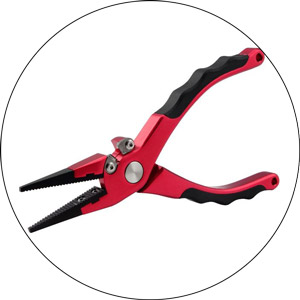


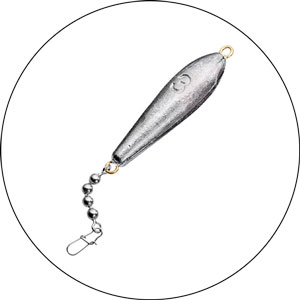
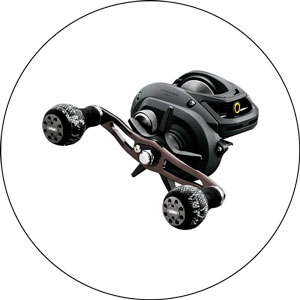
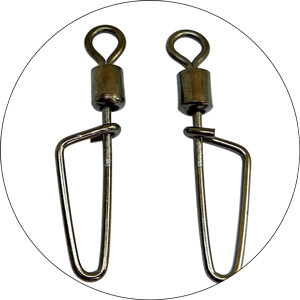
The article offers a comprehensive guide to the most popular and effective fishing knots used by anglers worldwide. It includes detailed instructions and images on how to tie each knot, along with their specific uses and advantages.
The author has done an excellent job of presenting the information in an organized and easy-to-understand manner. The article covers essential knots for various fishing scenarios, such as the Palomar knot for tying hooks and the Surgeon’s knot for connecting two lines.
Moreover, the article also discusses the pros and cons of each knot, helping readers make informed decisions on which knots to use in different situations.
Overall, the article is a useful resource for both novice and experienced anglers looking to improve their knot-tying skills. It provides valuable insights into selecting the right knot for different fishing techniques and conditions, making it a worthwhile read for anyone interested in fishing.
I’ve been using the improved clinch knot for over two decades but recently decided to give the uni-knot a try. And let me tell you, I am now a convert! The uni-knot is incredibly easy to tie and has a variety of uses – from forming end loops and joining lines to making droppers and snelling hooks.
One thing I love about the uni-knot is that if you run the loop of the line through the eye of the hook a second time before tying, you can create the “fishing fool” knot. It’s a handy little knot to have in your arsenal and has saved me time and time again.
Plus, you can double the lineup for an even stronger uni-knot. It’s a versatile knot that I highly recommend giving a try.
In my experience, I think it’s better to skip the improved clinch knot and go straight for the uni-knot. Not only is it easy to tie, but it’s also incredibly versatile. This year, I’ve joined lines and used droppers for the first time, and the uni-knot has been a game-changer for me.
I have to admit, I was a little anxious about trying the uni-knot at first. It can be tough to break old habits and try new things, especially when you’re relying on them to catch fish. But I’m so glad I took the leap of faith and tried it out.
The uni-knot has proved to be reliable and straightforward, and it’s now my go-to knot for a variety of fishing scenarios. If you’re new to fishing or looking to improve your knot-tying skills, I highly recommend giving the uni-knot a try. You might be surprised at how quickly it becomes your favorite knot.
I used to be a die-hard fan of the improved clinch knot, but that all changed when I lost a massive bass last year. I suspect that I may have missed the “improved” part of the knot by not going back through the loop, and it cost me dearly.
It took a lot of courage for me to try tying a new knot, but I eventually gave the uni-knot a shot. And boy, am I glad I did! The uni-knot is incredibly versatile and straightforward once you get the hang of it. I now use it for everything from forming end loops to joining lines and making droppers.
Breaking old habits and trying new things can be tough, especially when your success on the water is on the line. But I strongly encourage you to give the uni-knot a chance. It’s easy to tie and versatile, and you might find yourself wondering why you ever bothered with the improved clinch knot.
The Palomar knot is both stronger and easier to tie than the improved clinch knot. It’s my go-to knot for drop shots and most line-to-lure/hook connections. However, it can be problematic when used with larger lures.
On the other hand, the improved clinch knot gives me more control over the strength of the knot and can be easily tied to anything. It’s a reliable knot that I use in a variety of fishing scenarios.
In addition to these two knots, there are several others that I find useful. The knotless knot is great for snelling, while the dropper loop/twisted dropper loop allows me to make my own rigs. The double surgeon’s loop is handy for quick connections using a cow hitch, while the perfection loop is similar to the double surgeon’s and can be used for mainline-to-leader connections.
Overall, having a repertoire of knots at your disposal can be incredibly helpful when fishing. Each knot has its strengths and weaknesses, so it’s important to choose the right knot for the job at hand. With practice, you can become a master of knot-tying and increase your chances of landing that trophy fish.
I’ve had great success using the San Diego Jam Knot in a variety of fishing situations. It’s versatile and can be used for splices, barrel swivels, bait hooks, lures, snelling, and even as a deterrent to horse theft!
I’ve found that when using a lighter test line, it’s important to make more loops around the main line to prevent a thermal breakdown during cinching. This will ensure that the knot remains strong and secure.
Here’s a helpful tip: before cinching the knot, wet the line and then draw down the knot. Next, draw the tag end, followed by the main line using a confidence pull. This technique has allowed me to meet or even exceed the original line’s tensile test.
Overall, the San Diego Jam Knot is a reliable knot that every angler should have in their arsenal. It’s easy to tie and can be used in a variety of situations. Give it a try and see how it works for you!
As an angler, you’re probably curious about which knot is the strongest or easiest to tie, and whether you can use the same knot on braid and fluorocarbon. Well, let me tell you, a well-tied knot is essential to landing fish, no matter where or what you’re fishing for.
After researching what professional anglers use, we’ve compiled a list of the best fishing knots. It’s worth noting that the Palomar, Uni, and Non-Slip Loop knots are popular choices for both freshwater and saltwater fishing.
These knots have been tested and proven to be reliable and strong, making them great options for joining your braided main line to a fluorocarbon leader or connecting your line to lures and hooks. So, whether you’re a seasoned angler or just starting out, it’s important to know and practice these knots to increase your chances of success on the water.
As an angler, it can be overwhelming to choose which knot to use for a particular situation. However, it’s good to know that even the pros only use a few tried-and-true knots that are strong, easy to tie, and fast.
When it comes to selecting a knot, there are several factors to consider such as the knot’s size, the direction of remaining tag ends, and its ability to resist debris. For example, the Blood Knot is a respected knot but has a reputation for hooking onto weeds, explaining why the Double Uni is more popular.
Looking at what experienced anglers use, we have derived a list of universally popular knots for both fresh- and saltwater fishing. These include the Palomar, Uni, and Non-Slip Loop.
Other popular knots used by the pros are the Rapala Knot, Snell Knot, San Diego Jam, Bimini Twist, and Kreh, or Non-Slip Loop Knot. In the following sections, I’ll provide a brief review of each of these knots and their suitability for different fishing scenarios.